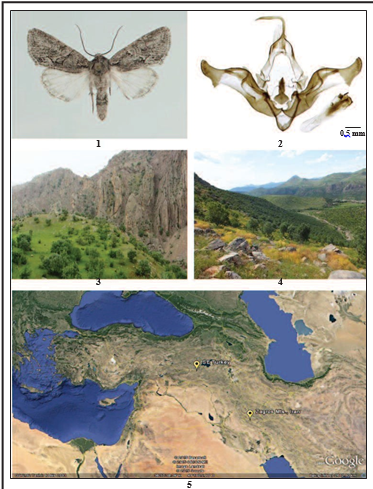

Second record of the rare noctuid species Dryobotodes glaucus Ronkay & Gyulai, 2006 (Lepidoptera: Noctuidae)
Segundo registro de la rara especie de noctuído Dryobotodes glaucus Ronkay & Gyulai, 2006 (Lepidoptera: Noctuidae)
Second record of the rare noctuid species Dryobotodes glaucus Ronkay & Gyulai, 2006 (Lepidoptera: Noctuidae)
SHILAP Revista de lepidopterología, vol. 44, núm. 175, 2016
Sociedad Hispano-Luso-Americana de Lepidopterología
Recepción: 30 Abril 2015
Aprobación: 30 Junio 2015
Abstract: Dryobotodes glaucus Ronkay & Gyulai, 2006 was known from a small area of the south-eastern Zagros Mountains of Iran. It is recorded for the first time from Turkey which is its second locality in the world. This paper includes morphological, ecological and faunistical features of the species.
Keywords: Lepidoptera, Noctuidae, Dryobotodes glaucus, new record, Turkey.
Resumen: Dryobotodes glaucus Ronkay & Gyulai, 2006 era conocida de una pequeña área del sudeste de las montañas de Zagros de Irán. Esta es la primera vez que se cita para Turquía lo cual es la segunda cita en el mundo. Este trabajo incluyen datos morfológicos, ecológicos y faunísticos de la especie.
Palabras clave: Lepidoptera, Noctuidae, Dryobotodes glaucus, nueva cita, Turquía.
Introduction
The genus Dryobotodes was proposed by Warren in 1910 based on the type-species Noctua protea [Denis & Schiffermüller], 1775 (at present Dryobotodes eremita (Fabricius, 1775)). The genus comprises 20 species in worldwide and most of them live in the Himalayan-Pacific region (RONKAY et al., 2001). Among them, D. tenebrosa (Esper, [1789], D. carbonis (F. Wagner, 1931), D. eremita (Fabricius, 1775), D. monochroma (Esper, 1790) and D. servadeii Parenzan, 1982 are known from Turkey (KOÇAK & KEMAL, 2009). The species D. glaucus is only known from a small area of the south-eastern Zagros Mountains, Boyerahmad-va-Kohgiluyeh (Iran) which is the type locality (RONKAY & GYULAI . , 2006). The second and faunistically new locality in the world, of that rare and local species is southeast of Turkey, Siirt, S¸irvan (Figure 5) (KOÇAK & KEMAL, 2009). This area located in the Irano-Turanian floristic region, contains different habitats and includes some common species from Iran, Iraq, Levant and the Caucasus region.
Material and methods
Specimens were captured by using UV light trap (18 W). Genitalia of species was prepared in the usual way (ROBINSON, 1976) and photographed with a digital camera (Olympus DP20) attached to a stereomicroscope (Olympus SZ61). Identification was performed by analyzing external morphological characteristics of adult moths and structure of the genital armature of male (RONKAY et al., 2001; RONKAY & GYULAI . , 2006). The specimens were collected for a doctoral thesis and have been deposited in the special collection of Dr. E. Seven (SES), Siirt, Turkey.
Results
Dryobotodes glaucus Ronkay & Gyulai, 2006
Bionomics: The collecting sit.es are well known deeper valleys on calcareous substrate with older oakwoods (RONKAY & GYULAI, 2006). Specimens were collected in rocky oakwoods of SE Turkey (Figures 3-4). The fly between October and November in S¸irvan disrict. Larval food plant(s) of the species are unknown.
Diagnosis: Wingspan 29-32 mm. Head and thorax dark grey, mixed with some black. Forewings unicoloured ashy grey with three spots, discal stigma reniform, hindwings significantly paler, almost whitish in colour (Figure 1). Male genitalia: Uncus long and slender. Valva long, narrow and curved at middle. Cucullus triangular with pointed apex and arcuate outer margin. Vinculum short and V-shaped.
Aedeagus short, tubular. Cornutus sclerous, den. tate and terminated in a sphenoid spine (Figure 2).
Distribution: Iran (RONKAY & GYULAI, 2006) and Turkey (new record).
Material examined: SE Turkey, Siirt province, S¸ irvan district, total 8 11 and 2 00: 6 11, 2 00, Çeltikyolu village, 1350 m, 3-XI-2013, 38º 08’ 22”N 42º 04’ 15”E; 1 1 S¸irvan-centre, 1000 m, 2-XI-2013, 38º 03’ 44”N 42º 01’ 48”E; 1 1, Nergizli, 650 m, 28-X-2013, 38º 01’ 23”N 41º 55’ 19”E (Gp124 1).

Dryobotodes glaucus Ronkay & Gyulai, 2006. 1. Adult male specimen (wingspan 31 mm), 2. Male genitalia armatures, 3-4. Habitats, Turkey, Siirt province, S¸irvan district, 3. Nergizli, 650 m, 13-V-2012, 4. Çeltikyolu village, 1340 m, 30-V-2013, 5. Known localities in the world.
Agradecimientos
The author sincerely thanks Dr. Ahmet Ömer Koçak and Dr. Muhabbet Kemal (Van, Turkey) for their help in identification of the species and for useful advice.
BIBLIOGRAPHY
KOÇAK, A. Ö. & KEMAL, M., 2009.– Revised Checklist of the Lepidoptera of Turkey. Centre for Entomological Studies Ankara, Priamus Supplement, 17: 1-253.
ROBINSON, G. S., 1976.– The preparation of slides of Lepidoptera genitalia with special reference to the Microlepidoptera.– Entomologist‘s Gazette, 27: 127-132.
RONKAY, L., YELA, J. L. & HREBLAY, M., 2001.– Noctuidae Europaeae. Hadeninae II, 5: 166-172. Ento- mological Press, Sorø. , pp. 166-172.
RONKAY, L. & GYULAI P., 2006.– New Noctuidae (Lepidoptera) species from Iran and Tibet.– Esperiana, 12: 211-241.